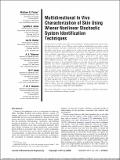Multidirectional In Vivo Characterization of Skin Using Wiener Nonlinear Stochastic System Identification Techniques
Author(s)
Parker, Matthew D.; Taberner, A. J.; Nash, M. P.; Nielsen, P. M. F.; Jones, Lynette A; Hunter, Ian; ... Show more Show less
DownloadHunter_Multidirectional in vivo.pdf (2.817Mb)
PUBLISHER_POLICY
Publisher Policy
Article is made available in accordance with the publisher's policy and may be subject to US copyright law. Please refer to the publisher's site for terms of use.
Terms of use
Metadata
Show full item recordAbstract
A triaxial force-sensitive microrobot was developed to dynamically perturb skin in multiple deformation modes, in vivo. Wiener static nonlinear identification was used to extract the linear dynamics and static nonlinearity of the force–displacement behavior of skin. Stochastic input forces were applied to the volar forearm and thenar eminence of the hand, producing probe tip perturbations in indentation and tangential extension. Wiener static nonlinear approaches reproduced the resulting displacements with variances accounted for (VAF) ranging 94–97%, indicating a good fit to the data. These approaches provided VAF improvements of 0.1–3.4% over linear models. Thenar eminence stiffness measures were approximately twice those measured on the forearm. Damping was shown to be significantly higher on the palm, whereas the perturbed mass typically was lower. Coefficients of variation (CVs) for nonlinear parameters were assessed within and across individuals. Individual CVs ranged from 2% to 11% for indentation and from 2% to 19% for extension. Stochastic perturbations with incrementally increasing mean amplitudes were applied to the same test areas. Differences between full-scale and incremental reduced-scale perturbations were investigated. Different incremental preloading schemes were investigated. However, no significant difference in parameters was found between different incremental preloading schemes. Incremental schemes provided depth-dependent estimates of stiffness and damping, ranging from 300 N/m and 2 Ns/m, respectively, at the surface to 5 kN/m and 50 Ns/m at greater depths. The device and techniques used in this research have potential applications in areas, such as evaluating skincare products, assessing skin hydration, or analyzing wound healing.
Date issued
2016-11Department
Massachusetts Institute of Technology. Department of Mechanical EngineeringJournal
Journal of Biomechanical Engineering
Publisher
ASME International
Citation
Parker, Matthew D. et al. “Multidirectional In Vivo Characterization of Skin Using Wiener Nonlinear Stochastic System Identification Techniques.” Journal of Biomechanical Engineering 139.1 (2016): 011004. © 2017 ASME
Version: Final published version
ISSN
0148-0731